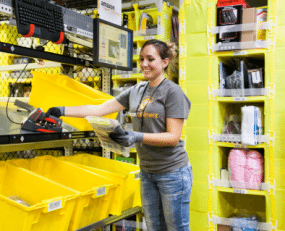
It is hard to know what is really going on inside Amazon’s warehouses. On the one hand there are press stories of numerous strikes breaking out across the world to protest at the demands the company is making on its workforce during ‘Prime Day’. Yet Amazon has said that hardly anyone has gone on strike and its workers are very happy.
The initial reports suggested that there would be a strike at a fulfilment centre in Minnesota. Certainly, there appear to have been some protests outside the facility, however the fulfilment centre itself seemed to be functioning. According to news reports, the issues concerning a proportion of the workforce were as much to do with their religious practices as the general working conditions. There also appeared to be heavy involvement by local politicians.
However, Amazon is stating to local media that the Minnesota facility saw only 15 workers strike, whilst it has been placing videos of workers laughing and dancing on its twitter news feed.
In Germany the situation appears to be more conventional with the Ver.Di union organising strikes at “seven locations…for at least two weeks”. According to the union, the action is focussed on “collective bargaining incomes such as in retail and mail-order business through recognition of regional collective agreements”.
Although elsewhere in the world there is considerable criticism of Amazon’s working conditions from trade unions and politicians, there does not appear to be any actual strikes.
Reading between the lines it would appear that Amazon’s operations have not been seriously affected by the industrial action, at least in the US. However, the issue of its warehousing workforce may be turning into something other than a personnel or operations issue. Journalists at the national level in the US have made Amazon the target of considerable vitriol and ridicule, contrasting the perceived conditions in its warehouses with the wealth of Jeff Bezos. This has in-turn attracted attention from politicians who sense a potential symbol for wider dissatisfaction. Amazon does appear to be picking this up, pushing-out stories on better integrating its “robots” with the humans working in its facilities. However, there is a danger that the company’s aggressive approach to warehouse automation could backfire and is laying itself vulnerable to wider attacks on its business model. This may have consequences for the automation of logistics operations.
Source: Transport Intelligence, July 18, 2019
Author: Thomas Cullen